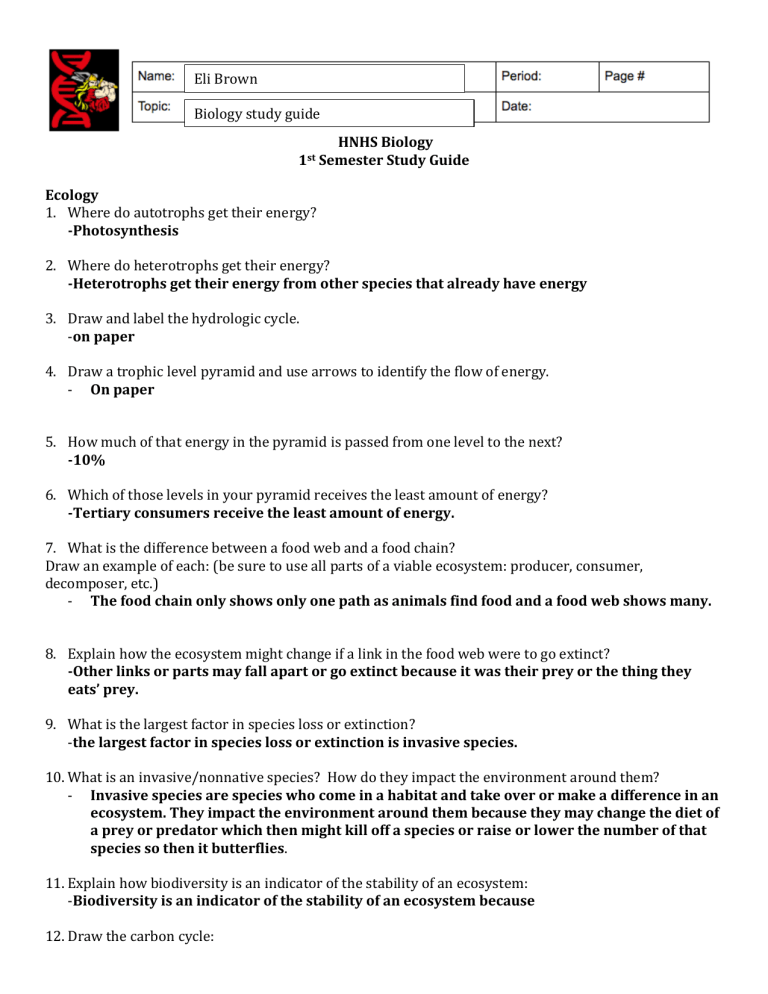2018+Semester+1+Study+Guide
advertisement

Eli Brown Biology study guide HNHS Biology 1st Semester Study Guide Ecology 1. Where do autotrophs get their energy? -Photosynthesis 2. Where do heterotrophs get their energy? -Heterotrophs get their energy from other species that already have energy 3. Draw and label the hydrologic cycle. -on paper 4. Draw a trophic level pyramid and use arrows to identify the flow of energy. - On paper 5. How much of that energy in the pyramid is passed from one level to the next? -10% 6. Which of those levels in your pyramid receives the least amount of energy? -Tertiary consumers receive the least amount of energy. 7. What is the difference between a food web and a food chain? Draw an example of each: (be sure to use all parts of a viable ecosystem: producer, consumer, decomposer, etc.) - The food chain only shows only one path as animals find food and a food web shows many. 8. Explain how the ecosystem might change if a link in the food web were to go extinct? -Other links or parts may fall apart or go extinct because it was their prey or the thing they eats’ prey. 9. What is the largest factor in species loss or extinction? -the largest factor in species loss or extinction is invasive species. 10. What is an invasive/nonnative species? How do they impact the environment around them? - Invasive species are species who come in a habitat and take over or make a difference in an ecosystem. They impact the environment around them because they may change the diet of a prey or predator which then might kill off a species or raise or lower the number of that species so then it butterflies. 11. Explain how biodiversity is an indicator of the stability of an ecosystem: -Biodiversity is an indicator of the stability of an ecosystem because 12. Draw the carbon cycle: - On paper 13. What is a density-dependent factor? Give an example of one: The density-dependent factor is a factor whose effects on the size or growth of the population vary with the population density. An example is the availability of food, disease and migration. 14. Explain how the introduction of a new species can lead to predation of native species: When a new and aggressive species is introduced into an ecosystem, it may not have any natural predators or controls. ... Native wildlife may not have evolved defenses against the invader, or they may not be able to compete with a species that has no predators. Biochemistry 15. Correctly list the monomers of each biomolecule: a. b. c. d. Protein- amino acids Lipid- glycerol and fatty acids Carbohydrate-monosaccharides Nucleic Acid- nucleotides 16. List the elements in each biomolecule: a. b. c. d. Proteins- hydrogen, nitrogen, oxygen, and carbon Lipids- carbon, hydrogen and oxygen Carbohydrates- carbon, hydrogen, and oxygen Nucleic Acids- nitrogen 17. What element is found in all organic compounds? -The element that is found in all organic compounds is hydrogen, oxygen and nitrogen 18. Explain how temperature and pH can affect protein function: -Temperature and pH can affect protein function because it will denature 19. What type of biomolecule is an enzyme and how do they work? -the type of biomolecule that an enzyme is a catalyst. They work by aligning molecules like nucleotides to make DNA. They can also make protein from amino acids Cells 20. What is the basic unit of life? -the basic unit of life is a cell 21. What is the difference between plant and animal cells? -The difference between a plant and animal cell is that plant cells don’t have cell membranes 22. Explain how some cells are just smaller components of much larger structures: 23. Compare and contrast prokaryotic cells and eukaryotic cells: 24. What are the three main points of the Cell Theory? -Three main points of the cell theory are 25. Explain why the cell membrane is said to be “fluid mosaic”: -the cell membrane is said to be fluid mosaic because 26. Give short descriptions of functions for each structure listed: a. Lysosome: b. Nucleus: c. Mitochondria: d. Chloroplast: e. Cell membrane 27. Explain osmosis: - Osmosis is 28. Explain why the diagram below depicts active transport: This diagram depicts active transport because there is only one flow of energy. From the outside in 29. Do substances moving by passive transport move from an area of high concentration to and area of low concentration OR from an area of low concentration to an area of high concentration? -substance moving by active transport do move from an area of high concentration to a an area of low concentration.


